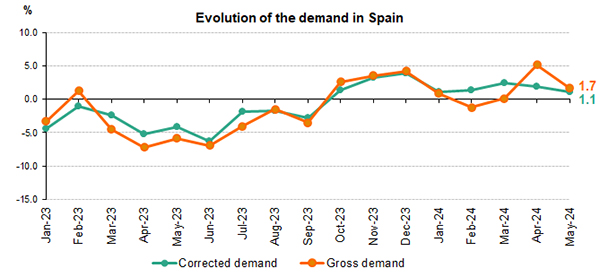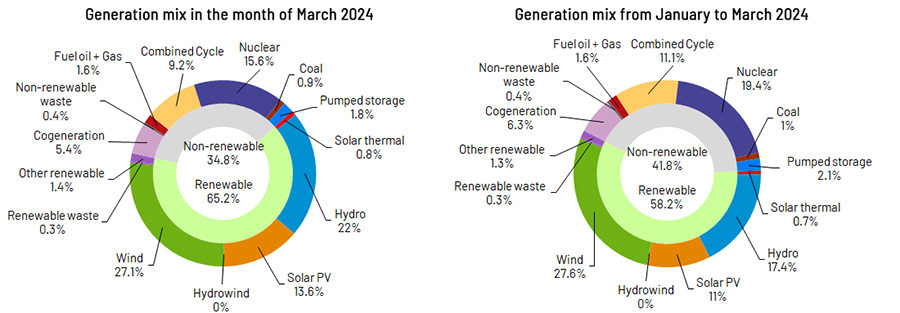For 40 years, we've been driving our country's economic and social progress. Four decades shaping Spain.
Spain's demand for electricity increases by 1.1% in May
- Solar photovoltaic energy became the leading technology in the Spanish generation mix for the first time in May, accounting for 23.8% of the total.
- Monthly generation with renewables in our country accounted for 63% and technologies that do not emit CO2 equivalent reached a share of 81.4%
- Electricity demand grew by 3.8% in the Balearic Islands and 2.8% in the Canary Islands, having taken the effects of working hours and temperatures into consideration.

National electricity demand increased by 1.1% in May compared to the same month of the previous year, after discounting the effects of temperature and working hours. In gross terms, demand was estimated at 19,432 GWh, 1.7% higher than in May 2023.

In the first five months of 2024, Spain recorded a demand of 101,423 GWh, 1.2% higher than in the same period of 2023.
This month, renewables generated 13,520 GWh, 16.4% more than in May 2023, reaching a share of 63% of the total to make this the first month in history in which solar photovoltaic has led the national mix, at 23.8% of the total. During this month, solar photovoltaic technology produced 5,098 GWh, a figure that represents an increase of 31.6% compared to May 2023, making it an all-time high in terms of both generation and the share amount.
It is worth noting that on 24 May, solar photovoltaic beat its daily production record with 199 GWh, representing a share of 29% of the total, the highest in its history in terms of the daily generation structure.
According to provisional data now available, wind was the second technology in terms of the highest electricity generation levels in May, at 20.2% of the total, followed by nuclear (16.5%) and hydro (14.3%).
With this increase in renewables, 81.4% of the electricity produced in Spain in May 2024 was free from CO2 equivalent emissions.

Demand in the Peninsula rises by 1%.
After taking into consideration the effects of working hours and temperature, demand was 1% higher in the peninsula than in May 2023. In gross terms, demand this month was 18,198 GWh, 1.5% higher than in the same month last year.
In the first five months of the year, demand in the peninsula was 95,493 GWh, 1.1% higher than that recorded in 2023.
Renewables in the peninsula generated 65.2% of the total in May, according to provisional data now available, which show a production of 13,261 GWh, 16.3% more than in the same month of the previous year. Emission-free technologies accounted for 84.6% of the total.
The generation structure in the peninsular in May was also led by solar photovoltaic energy, which was responsible for 24.6% of the total, producing 5,007 GWh during the month.
The electricity system in the Balearic and Canary Islands
In the Balearic Islands, electricity demand in May was 3.8% higher than in the same month of 2023, after considering the effects of working hours and temperatures. Gross demand was estimated at 482,454 MWh, 4.9% more than in May last year. From January to May 2024, gross demand in the Balearic Islands was estimated at 2,194,167 MWh, 1.4% more than in the same period of 2023.
In terms of generation, combined cycle, which accounted for 59.2% of the energy produced in the Balearic Islands, was the leading source this month. The generation of renewable energy without CO2 equivalent emissions in the Balearic Islands accounted for 20% of the total, the highest share ever recorded in the archipelago. Renewable generation in the Balearic Islands grew by 54.6% in May compared to the same month last year.
In addition, the underwater link between the peninsula and Majorca helped meet 24.4% of the Balearic Islands' electricity demand during the month.
Meanwhile, in the Canary Islands, electricity demand grew by 2.8% compared to the same month in 2023, considering the effects of working hours and temperatures. In gross terms, demand was 719,502 MWh, up 2.5%. In the first five months of 2024, demand in the Canary Islands is estimated at 3,581,092 MWh, 3.5% more than in the same period of 2023.
In terms of electricity generation in the Canary Islands, combined cycle, with 38.4% of the total, was also the leading source in May. Renewable and emission-free technologies reached a share of 25.8% of production, with wind power accounting for 20.9%. Canary Islands renewable energy production in May grew by 12% compared to the same month in 2023.
Please see our Daily balance report for further information on the national, peninsular, Balearic Islands and Canary Islands electricity systems up to the end of May.
Downloads












